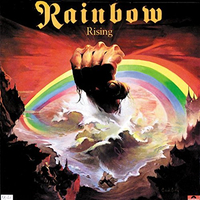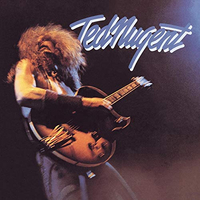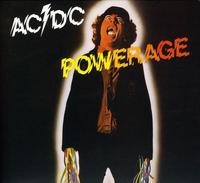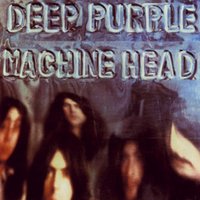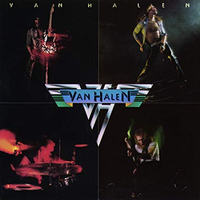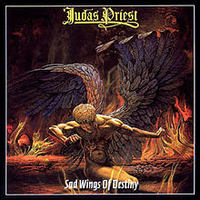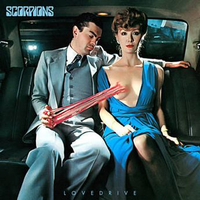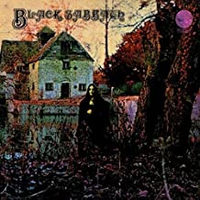10. Rainbow - Rising (Polydor, 1976)
Having fired the line-up that recorded the debut Ritchie Blackmore’s Rainbow, apart from singer Ronnie James Dio, former Deep Purple guitarist Blackmore brought in drummer Cozy Powell, bassist Jimmy Bain and keyboard player Tony Carey and brought out the magic that everyone knew was inherent in Rainbow.
Rainbow’s next album, Rising, was the epitome of the quality hard rock Blackmore was searching for, before a passion for more commercially minded material sent The Man In Black off in search of an ever increasing array of musicians.
The vinyl version’s side one was packed with quality melodic hard rock, thanks to Tarot Woman, Run With The Wolf and Starstruck, with all the musicians at the top of their game. Side two had everyone openmouthed in awe; Stargazer remains the finest moment Rainbow ever achieved in the studio.
As iconic as Rising’s sleeve, which depicted a mystical hand rising from the water and clutching the obligatory rainbow, this towering, Eastern themed rocker features a mesmeric performance from Blackmore, and perhaps Ronnie Dio’s greatest ever performance on record. It produced a feeling of awe in listeners, and can still send shivers down the spine today.
9. Motorhead - Overkill (Bronze, 1979)
The ferocious eruption of double-kick percussion that kick-starts Overkill, the opening track of Motörhead’s second album, still sends shivers down the spine.
With two false endings (a trick probably nicked from Status Quo), Overkill was an apocalyptic introduction to a 10-song collection that sent tremors through the hard rock world. Were Motörhead a hard rock band, or were they punks? It could even be proposed that they were responsible for propagating the US thrash metal assault that became popular several years later.
In fact the trio were none of these. “We were a blues band, although we played at 1,000 miles an hour,” claimed Lemmy Kilmister, the bass goliath who had been judged to be too wild even for Hawkwind. Listen to (I Won’t) Pay Your Price, No Class and Damage Case and you’ll understand what he means.
Jimmy Miller, of the Rolling Stones fame, was perhaps an unusual choice to have produce the album, although for all the record’s stripped down clarity, heaviness and propulsive qualities he made the group – completed by guitarist ‘Fast’ Eddie Clarke and the formidable Philthy ‘Animal’ Taylor on drums – sound claustrophobic, wasted, irritable and gloriously unwashed. Which of course they were in life.
8. Ted Nugent - Ted Nugent (Epic, 1975)
Comin’ straight outta The Amboy Dukes, a psych-rock band signed to Frank Zappa’s DiscReet label, Ted Nugent reinvented himself after he signed a major deal with Epic. From being the dippy guitarist behind songs such as the bonkers-titled Why Is A Carrot More Orange Than An Orange? was transformed into a raw-meat-munchin’ miscreant of the highest order.
With his career being looked after by the mighty Leber-Krebs organisation (who also managed Aerosmith back in the day), Motor City man Nugent became a hot property. In the recording studio, everything came together magically on his 1975 album Ted Nugent. Untainted by the insane blathering and disconcerting sameness that would ruin many of his later records, this one has it all: the band (Derek St Holmes, rhythm guitar/vocals; Rob Grange, bass; Cliff Davies, drums) are vice-tight throughout, and Nugent’s guitar playing is incendiary.
There are some superbly snappy hard rock songs on this record (Hey Baby, Snakeskin Cowboys, Motor City Madhouse) but the standout track was, and remains, the sprawling Stranglehold. More than any other album, Ted Nugent sums up the intoxicating, uninhibited spirit of American rock’n’roll in the mid-70s.
7. AC/DC - Powerage (Atlantic, 1978)
There are better-known AC/DC albums, such as 1980’s mega-selling Back In Black, but few captured the raw intensity of the band’s electrifying live performance as well as 1978’s Powerage. It was the album on which boys had become men, and contained some of AC/DC’s most primeval material, delivered with a predatory attitude from vocalist Bon Scott, who was at the top of his game.
Sin City, Riff Raff and Rock ’N’ Roll Damnation are perhaps the album’s best-known tracks, but many diehard AC/DC fans point to the raging fury of Up To My Neck In You, Gimme A Bullet and What’s Next To The Moon as fine examples of their continuing development as one of the genre’s leading lights. Add to that the sinister feel of Cold Hearted Man and the bludgeoning sensation of Kicked In The Teeth and you have pretty much the consummate AC/DC package.
Powerage was the last AC/DC album to be produced by George Young (brother of Angus and Malcolm) and Harry Vanda before ‘Mutt’ Lange’s glossy sheen would catapult the band into superstars with 1979’s Highway To Hell, and it’s not difficult to see why many fans reckon Powerage to be AC/DC’s ultimate statement.
6. Deep Purple - Machine Head (Harvest, 1972)
The album for which Deep Purple Mk2 will always be known, and which brought together all the best elements displayed on its predecessors In Rock (1970) and Fireball (1971).
On Machine Head the band seemed driven by an irresistible force. Each track slots into a seemingly organic role. From the motorvatin’ Highway Star to the more jam-oriented Space Truckin’, it displayed the full range of the five men’s talents.
Recording in the Montreux Grand Hotel in Switzerland, using the Rolling Stones Mobile studio, Purple struck a balance between musical intensity and a relaxed vibe that allowed everything to flow. The fastpaced Pictures Of Home boasted an inspirational Ritchie Blackmore guitar riff, butting against Ian Gillan’s almost forlorn lyrics, while Lazy is a prime example of the way Blackmore and keyboardist Jon Lord could swap roles and solos. And, of course, the album featured the song that tells the story of how the Montreux Casino (which Purple had originally intended to rent to record the album in) burnt down during a gig there by Frank Zappa And The Mothers Of Invention.
Could Deep Purple ever have thought that track, Smoke On The Water, would take on a life of its own. The most iconic riff in metal history? It’s certainly up there.
- Less noise, more rock with the best noise cancelling headphones
- Best over-ear headphones: great options to suit all budgets
- The best smart speakers: find the right voice-assisted speaker for you
- Own your idols with the best Funko Pop! Rocks vinyl figures
5. Van Halen - Van Halen (Warner Bros, 1978)
Just when everyone thought the guitar had no further surprises to offer. Just when the metal world was settling down to a comfortable, predictable period… along came a hot-blooded, arrogantly souped-up gang from California, ready to turn heads, twist reputations, and bring us all to new heights of ecstasy.
Like Montrose five years earlier, Van Halen said it all with their debut album. They never bettered the record, in terms of impact, style or cheek. From the moment Runnin’ With The Devil opened with that backward car horn effect – one Kiss’ Gene Simmons claimed to have suggested – you knew this foursome were different.
The combination of David Lee Roth’s richly libidinous vocals and Eddie Van Halen’s fluidly flashing guitar sound set them on the path to excess – in every aspect. Eruption showcased an Eddie solo that had every wannabe within reach of a fretboard throwing away the rule book. Ain’ Talkin’ ’Bout Love was a cascading anthem. Atomic Punk dared you to meet up in a dark alley, and On Fire closed out the session with a pyrotechnic display of assured frenzy.
Perhaps the closest we’ll ever get to a metal sex machine, this album was an overpowering torrent of testosterone.
4. Judas Priest - Sad Wings Of Destiny (Gull, 1976)
Amazingly, Judas Priest had been in existence for some six years before conjuring up this heavyweight slice of metal magnificence.
Prior to the release of Sad Wings…, guitarist KK Downing and bassist Ian Hill had played around the English midlands with various line-ups but with little success. And Priest’s debut album, Rocka Rolla (1974), had disappeared off the radar quicker than a UFO over Roswell.
With singer Rob Halford and guitarist Glenn Tipton now firmly settled into the Priest line-up, bonkers tracks like Caviar And Meths were consigned to the dustbin, and a brand new era dawned with this, the band’s second record. There have been many facets to Priest’s music over the years (the techno-rock of Turbo, the brutal intensity of Painkiller), but many fans will point to Sad Wings… as a career highlight.
Priest preened and postured like the prog-metal princes they were. Halford’s voice flows from the speakers like molten lava, and the formative twin-guitar attack of Downing and Tipton refreshes the parts a single axe just can’t reach. The album begins apocalyptically (Victim Of Changes) followed by the lacerating The Ripper, before hitting its stride with the cataclysmic Tyrant and Genocide on side two.
3. Scorpions - Lovedrive (Harvest, 1979)
It would take something truly special to maintain the momentum generated by the Scorpions’ 1978’s double live album Tokyo Tapes. And to also steady the ship after the departure of guitarist Uli Jon Roth’s. And this album was.
Sporting a risqué cover (apparently shot in the back of Elton John’s Rolls-Royce), Lovedrive achieved far more than mere consolidation. It became the German group’s first gold-certified album in America, and gave them a genuine foothold in the commercially crucial US market.
It did so against the odds. In order to accommodate the arrival of rhythm guitarist Rudolf Schenker’s brother Michael, Roth’s replacement in the Scorpions, guitarist Matthias Jabs, was ‘let go’ following the recording of the album. Three tracks – Another Piece Of Meat, Coast To Coast and Lovedrive – feature Michael’s solos, but after the touring implosion Jabs came back for more.
With a combination of rapier-sharp hard rock anthems (Loving You Sunday Morning, Can’t Get Enough) and ballads tailor-made for radio (Holiday, Always Somewhere), Lovedrive was slicker and more polished than anything the Scorpions had attempted before. Going Top 60 in the US was an incredible achievement.
And while the band would make far bigger-selling records, the superb Lovedrive remains cherished for its key role in the band’s rise to fame.
2. Montrose - Montrose (Warner Bros, 1973)
The greatest debut album of all time? Don’t bet against it.
Montrose came outta nowhere with an unknown called Sam (as he was know back then) Hagar on vocals and a coupla guys who’d noodled on Van Morrison sessions in the past: guitarist Ronnie Montrose and bassist Bill Church. Ronnie had also gained some notoriety by playing guitar in the Edgar Winter Group, but until this point he’d given no real hint of his amazing abilities as a dazzling fretmaster par excellence (particularly not on Morrison’s Tupelo Honey). The Montrose line-up was completed by drummer Denny Carmassi.
Really, Montrose should be retitled Monstrouse. From rampant opener Rock The Nation to the revved-up Bad Motor Scooter, to the cosmic twitterings of Space Station No.5, this is primeval pandemonium topped with liberal amounts of cool American gloss.
Even today, nearly 50 years down the line, the record’s power remains undiminished. If a band came along sounding like this in 2020, they’d be hailed as the saviours of rock’n’roll. Yes, Montrose is that timeless.
Of course, the hot, sweet and sticky standout track on this album is Rock Candy. Full of E-chords rather than E-numbers, it’s the rock’n’roll equivalent of a sugar rush.
1. Black Sabbath - Black Sabbath (Vertigo, 1970)
This is where it really began. Yes, there were bands – and albums – before this one that hinted at what was about to happen. And yes, Sabbath had their influences. But it was on this, their eponymous debut, that Ozzy, Tony, Geezer and Bill invented heavy metal as we know it today.
Any Trivium, Slipknot or Mastodon fan will recognise what’s going on here – and with a record released 50 years ago. Legend has it that the band stopped off to record this album in a rush, on the way to playing shows in Germany, and the production (by Rodger Bain) is virtually non-existent.
But that’s part of the reason why the record has held up so well over the years. It’s about the raw passion. It’s about guitarist Tony Iommi’s riffage, circling over you like a nightmarish flock of vultures. It’s about Ozzy Osbourne's nasal vocal twang. And, mostly, it’s about a collection of songs that still hold us all in their thrall even now: the dyspeptic blues of The Wizard, the dreamscape drift of Behind The Wall Of Sleep, the mysterious N.I.B., which is a love song (and the initials don’t stand for Nativity In Black).
But most of all it’s about the title track. If you ever come across anyone who’s never heard a note of metal music, and they ask you explain it to them, just sit them down, turn up the volume and play the song Black Sabbath, because this is the definition of the genre. Nothing else need be said or added. The whole of metal is contained in this one remarkable track. Everything since has been based on what Black Sabbath did here. Ominous, claustrophobic, overwhelming, mournful, pacey… it’s a climactic tour de force. And it’s the opening track on the first album by the forefathers of metal.
Welcome to the beginning.
Classic Rock Newsletter
Sign up below to get the latest from Classic Rock, plus exclusive special offers, direct to your inbox!
